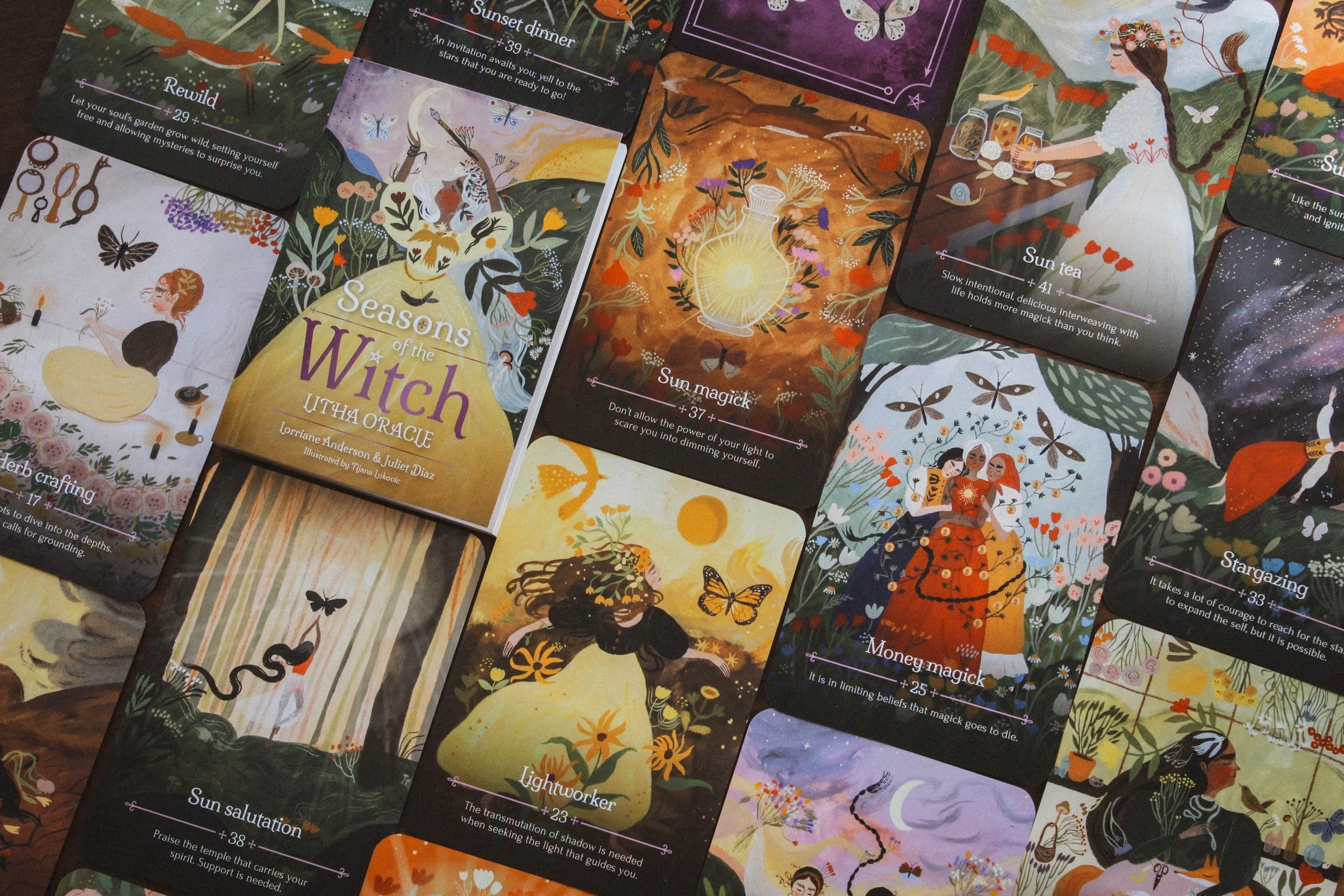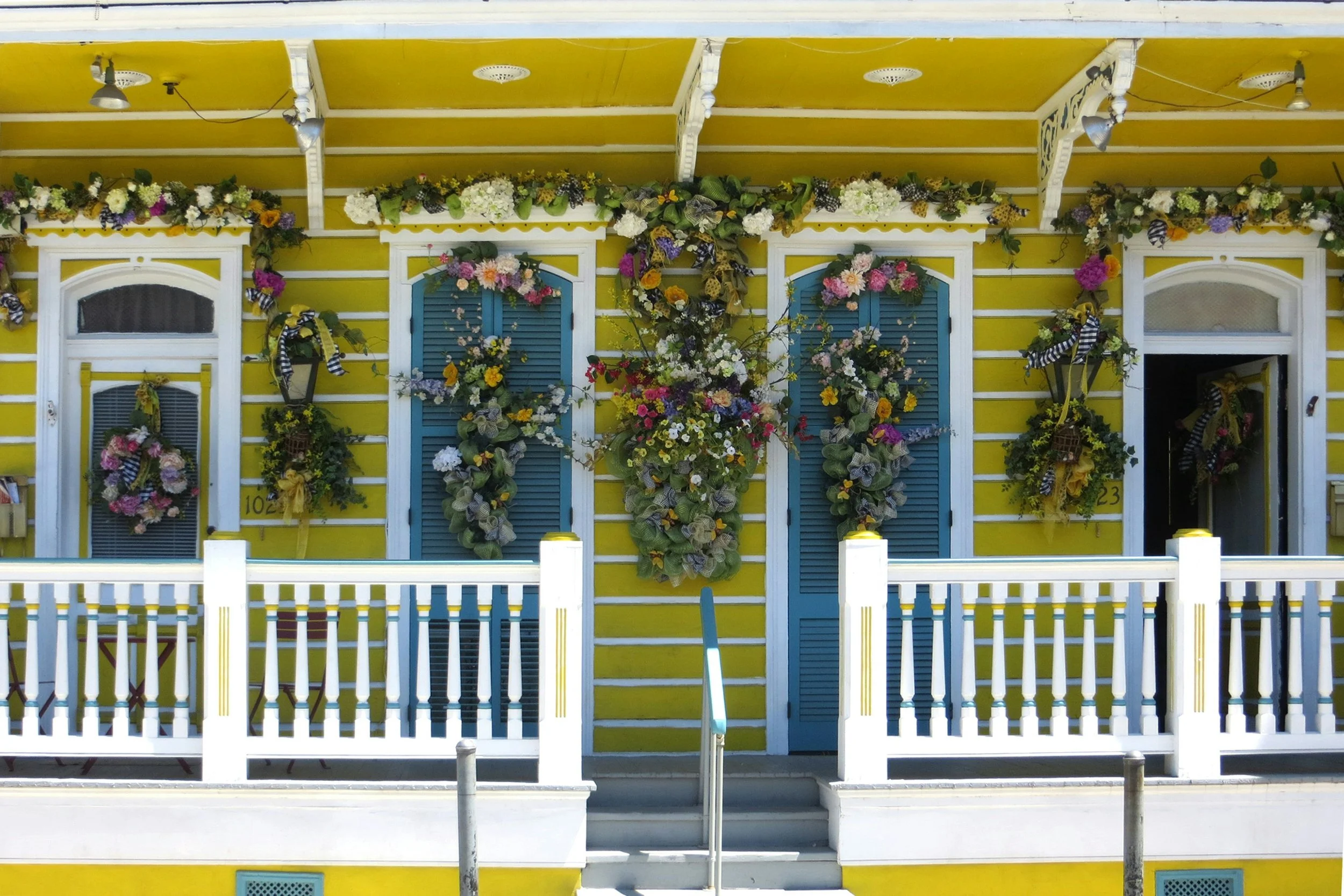Hanging Baskets: a Welcoming Invitation to Your Business, Your Home, and Your Heart
Normally I keep my personal spiritual practice fairly private and especially separate from my professional work, but I have so much to express at the moment. I may even change that rule altogether.
I’ve been experiencing a special bond with my newest Oracle deck. The repeated pull of a specific card has spurred an emotional epiphany about myself. I’m eager to pour all these revelations onto the page.
The card in question? Hanging baskets.
It must seem like a hanging planter has little or nothing to do with running a business but I’m convinced it does. Let’s explore this together.
Seasons of the Witch
I’ve spent the last year(ish) learning how to incorporate cards in my practice. I began with Tarot but was soon compelled to make the switch to Oracle after I kept hearing about this deck series: Seasons of the Witch. It came into my periphery just after the New Year when I heard a favorite podcaster pulling from the Samhain and Yule editions. As I looked into it I was delighted to see an Imbolc deck–literally right before Imbolc 2024.
Now, I don’t know much about the Wheel of the Year or witch’s sabbats but was obviously excited to explore. What better way to learn Oracle and become acquainted with the Wheel of the Year all at once? I ordered the Imbolc deck and felt its pull and its significance immediately. I loved every day I spent with it. The Ostara deck is still in production so next in line was Beltane, quickly followed by the just-released Litha deck (that I of course pre-ordered!).
Let’s talk about the team behind the deck for a moment: Written by Lorraine Anderson & Juliet Diaz; Illustrated by Tijana Lukovic. When I first looked into the decks, the name Juliet Diaz rang a bell right away. She had been a guest (twice!) on another favorite podcast of mine: The Witch Wave with Pam Grossman. Cue Pam’s voice in my head, telling me to “follow the trail of cosmic breadcrumbs” and buy this deck, buy all the decks! Now! Yesterday!
Photo from Lorraine Anderson’s blog at SpiritElement.com
The contents of each deck reflect the themes of each sabbat. Litha, or the Summer Solstice, for instance, is about celebrating life, growth, and abundance. The deck then further explores wealth consciousness, confidence, outer and inner beauty, independence, and happiness.
These decks have been a wonderful tool for me as I build my copywriting business. They offer me insight, increase my emotional intelligence, and challenge me to believe in myself. I’ve become more in tune with myself, more clear about my goals, and able to shed what no longer serves me.
Here’s where it gets interesting.
Hanging Baskets
Each card in these decks features an original illustration containing a recurring visual element (Litha’s is a butterfly) and an incantation. Hanging baskets reads:
Lean into the essence of receiving, for there await the
things you’ve been telling yourself are out of reach.
The keywords for this card, provided by the accompanying guidebook are: attraction, beauty, learning to receive.
“Nothing says welcome to a warm, beautiful home full of cheer better than a hanging basket,” the guidebook begins.
A hanging basket will literally attract all kinds of beautiful creatures, like butterflies, bees, and hummingbirds. So too can you attract all kinds of fantastic, lovely things when you put your beauty on display.
Here, the guidebook carefully points out that this is less about physical beauty and much more about confidence and allowing your light to shine as brightly as possible.
I’m finding that is true for the home, the self, and a business. And here’s where you may be asking, “literally or figuratively?” The answer is both.
But how could I translate this wonderful guidance into a convincing, physical tool?
The Ancient Art of Attraction
Imagine my surprise when some simple, wishful Googling led me directly down a rabbit hole of history.
Turns out, the history of the hanging basket (and houseplants in general) dates back to 600 BCE and the Hanging Gardens of Babylon. Declared one of the Seven Wonders of the World, the mythic gardens were–according to legend–built by King Nebuchadnezzar II for his wife, Queen Amytis. The gardens were meant to remind the Queen of her homeland, a beautifully lush, mountainous place which she missed dearly.
The Hanging Gardens of Babylon
Ferdinand Knob, public domain
The tiered gardens featured high walls, stone pillars, and bases deep enough to allow proper room for intricate root structures that could not have otherwise thrived in Babylon’s natural land.
The stories of this ancient marvel essentially inspired the art of gardening for pleasure over necessity, beauty over survival. In fact, they’re also a precursor to social and cultural traditions such as May Day Baskets and the Victorian Language of Flowers. A family estate’s garden or a wedding’s floral arrangements could just as easily attract judgment as they did praise.
All splendor and beauty aside, domestic use of flowers and greenery served as its own language in society; invitations that one needed to issue carefully, wisely, and with great discretion. You know how it is, we’ve all seen Downton Abbey.
Photo © Nick Briggs/Carnival Film & Television Limited for Masterpiece on PBS
Get Your Fern On
Houseplants and flower gardens may have only belonged to those of a higher economic tier in centuries past, but today, as we all know, pets are the new kids, and plants are the new pets.
According to Plant Savvy–a plant design and installation company based in Nashville–ferns were so immensely popular and so highly coveted during the Victorian era, the fad was given its own term: Pteridomania or “fern madness.” Imagine!
Nowadays you could buy a fern basically anywhere, from a nursery, a garden center, even a Whole Foods. And have you checked the internet? It’s a jungle out there. We are living in a time of unprecedented accessibility where potted plants and window boxes are now for anyone who wants to grow and nurture something.
Photo by Bohdan Stocek on Unsplash
Biophilia and Your Business
Plant Savvy has an amazing blog that discusses interiorscaping –the practice of bringing plants into interior spaces “with design elements, function, and biophilia in mind.” Biophilia is the theory that humans have an innate tendency to interact with other forms of nature.
Interiorscaping therefore quenches our natural thirst to be close to nature when confined to an industrial landscape, as so many of us today are. Plant Savvy insists that by bringing plants and greenery into commercial spaces, clients and consumers will feel satisfied by their closeness to the natural world, experience a subtle yet natural euphoria, and begin to associate that business with those positive feelings of safety, happiness, contentedness, and comfort.
Photo by Petr Sevcovic on Unsplash
Utilizing that kind of natural, electric energy just makes good business sense.
If you have a brick and mortar business then consider this your invitation to bring some life into your space. Use the physicality of plants and flowers to attract more business, more positive reviews, and a more faithful client base.
Photo by Mark Billante on Unsplash
It says, “Please, come inside, doesn’t it look nice here? We nurture things here. We thrive and grow and blossom and breathe. Won’t you come in please? You’re safe here.”
If you work from home, this same invitation stands. Vamp up your workspace with a succulent–succulents are so hot right now and so easy to care for.
If you find yourself in need of stability and discipline in your work-from-home routine, then a higher-maintenance plant. Whether you’re an employee or your own boss, regimented care for your potted pets could help stimulate your own growth with responsibility and accountability.
Let’s also not forget the simple science of plant life harboring mood-boosting effects like increased joy and creativity.
The Essence of Receiving
Here’s where we round the corner and it all comes full circle.
Did this research on hanging baskets make me want to buy more plants? Absolutely. But the Oracle card made me learn so much more about myself.
“Do you duck your eyes when you see someone attractive rather than meet their gaze?”
You bet I do. I’ve known my husband for 8 years and I still struggle with eye contact. But so what? I’m just shy, right?
I think we all know how wrong that is.
“No one can enter your house if you don’t open the door. Learning to receive is as much about putting yourself out there as it is about accepting what is being offered to you.”
The closing words of the guidebook’s passage hit me like a ton of bricks.
I don’t know how to receive.
As a chronic people-pleaser, receiving is just not in my vocabulary. I can give, I can deflect, but receive? Attract? I don’t do that.
It was an awful realization. Fundamentally we all understand the law of attraction, but so few of us believe in it enough to propagate anything worthwhile.
Photo by Lisa Yount on Unsplash
So I’ve decided to make some changes: I’ll bring more plants inside, I’ll whisper encouraging words to them to help them grow, I’ll say thank you for thriving, I’ll put them in the sun and give them clean water to drink. I’ll open those doors wide and say “Welcome!”
I’ll say “Thank you” as much as I can. I’ll find pleasure in compliments and praise, and I’ll smile instead of squirm. I’ll breathe more deeply and see more clearly and no opportunities will pass by unnoticed. I’ll thrive and grow and cultivate and nurture.
I want to attract all sorts of beautiful, colorful, fantastical creatures.
Now, you may be asking, “what are all these optimistic resolutions for?” My business? My home? Myself?
Obviously, beautifully, all three.











